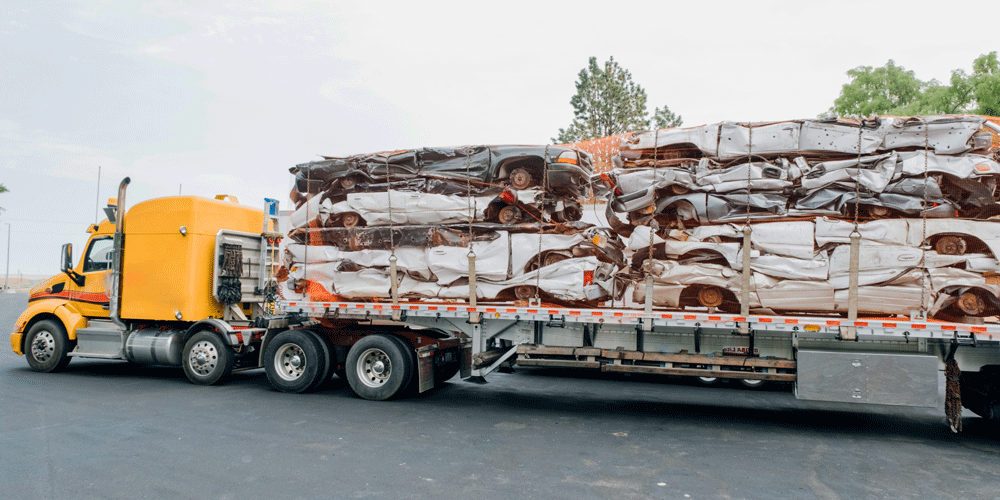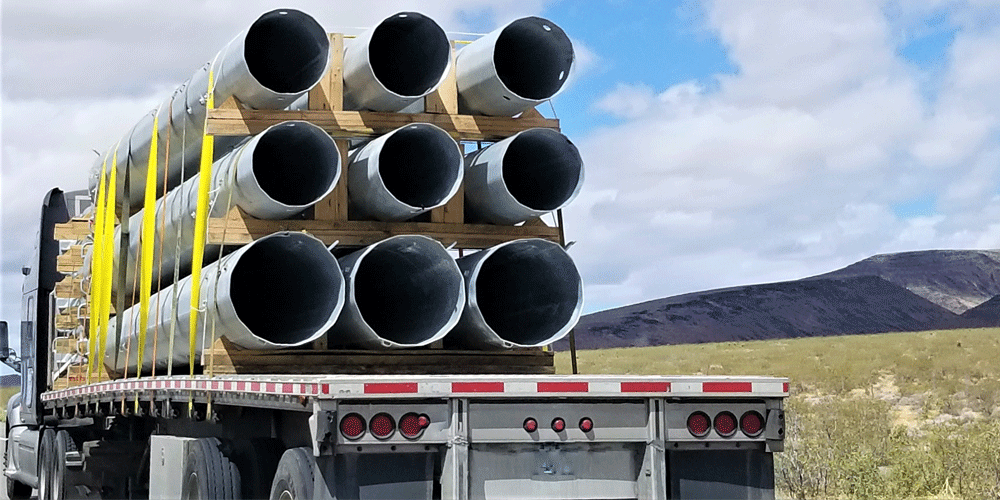Help! I Don’t Know How to Secure My Freight [Flatbed Load Securement Help]
Jodi has been with ATS as a specialized driver manager since 2018. She manages a fleet of 40 drivers. She loves that she gets a chance to be part of the execution process. There’s never a dull moment in her very challenging but very rewarding position.
Stuck hauling a load you have no idea how to secure?
That can be a scary feeling. You don’t want the load to slide and fall off your trailer, risking hitting a passerby and injuring them. And you also don’t want to be late delivering the load and potentially risk disappointing the customer.
Safety should always be one of your values as a truck driver, which means you shouldn’t rush or leave a shipper without being totally confident in your securement. The risk is never worth it. Your freight could slip — which causes a lot of time and money spent getting it back into place — or you could lose your cargo entirely — which will also make you lose your job. You could also seriously injure someone or yourself if your securements were to fail.
If you’re new to flatbed hauling from the dry van or reefer side of things, there’s a lot to learn. It isn’t just a matter of hopping in the truck and driving off to your destination. Not only can it take longer to get loaded, but you might also be securing and tarping for another few hours after you’re loaded. On top of that, you’re required to regularly stop to check your securements to ensure they’re holding.
As a specialized driver manager at Anderson Trucking Service (ATS), I regularly consult drivers on cargo securement.
The following tips will help you in situations when you’re unsure how to secure your freight, including the following:
- Call your driver manager for assistance
- Consult FMCSA guidelines
- Get a driver mentor
- Watch videos for inspiration
- Pursue additional training
Call Your Driver Manager and Cargo Securement Department
If you aren’t sure how to secure your load, your first step should be to reach out to your cargo securement department or safety team (if you have one) and your driver manager. Send a photo of your load and call them.
Maybe you’ve started securing the load, maybe you haven’t. Either way, your trucking company will be able to help you through the entire process — no matter which step you’re struggling with. They’ll help you work through the problem step by step. Again, make sure you send them sufficient photos of the load; they should already know its dimensions and weight.
Here at Anderson Trucking Service (ATS), you’ll need to send a picture to our securement line, which automatically goes to your driver manager and the cargo department. Either department will be able to provide advice. All of our specialized driver managers go through the same securement training our drivers go through.
Even after you’ve received feedback from your trucking company and given tips on what to do next, it’s a good idea to send a photo of the final secured load for review.
At ATS, we have a securement picture program. Depending on how much experience a driver has when they start driving with ATS, they’re required to send photos of their secured loads for a set number of loads.

Consult FMCSA Guidelines
Ideally, the company you drive for will provide you a securement “cheat sheet” including visuals and information about the size of the chains and straps you’re using and how much weight they’re rated for. You can also consult the notes you (hopefully) took during securement training (if you had securement training at the company you’re driving with).
If either of these isn’t helping you or you need more information, the Federal Motor Carrier Safety Administration (FMCSA) has published cargo securement rules. Refer to their website for information regarding the proper use of tie-downs, minimum working load limits, the minimum number of tie-downs and special rules for specialized freight. You can also refer to the FMCSA for specific guidelines when it comes to hauling freight such as logs, lumber, metal coils, paper rolls, concrete pipe, intermodal containers and more.
Get a Driver Mentor
Getting a driver mentor out on the road is a great idea. They can help you navigate the trucking industry if you’re a newer driver. Most specifically, they can help you by providing securement tips and tricks.
When I have a newer driver in my fleet, I always connect them with my more experienced flatbed drivers. Whenever the newer driver is struggling, they reach out to their mentor for tips.
Ask your driver manager if there’s a driver they’d recommend you speak with. If it isn’t an option at the company you’re driving for, seek out your own mentor at the truck stops you frequent. When you’re parked for the night or fueling, look for drivers hauling similar freight and spark a conversation. When you build a strong relationship with more experienced drivers, it can turn into a great mentorship opportunity.
Keep in mind, if your mentor drives for a company different than the one you drive for, you may be following different regulations. Sure, every driver needs to follow the regulations set forth by the Department of Transportation (DOT), but some companies have additional requirements or customer requirements that must be adhered to.
For example, ATS has a strict policy that enforces more securement than the DOT requires.
While your mentor could be teaching you correctly, they likely don’t know the specific regulations you must follow with the company you’re driving for.
If you do have a driver mentor, you should always check with your company to get the final word on whether you secured your load properly.
Related: Find out how one ATS driver makes securing easier

Watch Videos for Inspiration
It’s always a great idea to pursue extra knowledge and training. That — combined with time and practice — will help you become better at securing your loads. You’ll probably become faster at it too.
You can refer to videos for help. Some trucking companies put out videos, as do your truck driver peers. You can use these videos for inspiration and to help you learn handy tricks for using your securement tools.
You just need to remember: Be careful who you watch and make sure they’re securing loads properly. When in doubt always consult your company for the final standard.
Pursue Additional Training
There’s nothing wrong with admitting you need help and further training. In fact, some drivers who’ve been hauling flatbed freight for years still come across freight they haven’t seen before; they aren’t afraid to ask questions about it.
It’s a great idea for drivers new to flatbedding to get a few loads under their belt and then go back to securement training classes with their company. Now that they have a little bit of experience, they can take the class again with fresh eyes and armed with questions they never thought to ask before. You may have encountered something on the road that you’ve been itching to ask about — this is your chance.

Gain the Securement Experience You Need to Succeed
When you find yourself in a situation where you don't know how to secure your load, it's important to prioritize safety and take the necessary steps to ensure proper cargo securement. The first course of action should be to contact your trucking company’s cargo securement department or safety team. They have the expertise and knowledge to guide you through the process, whether you have already started securing the load or not. Sharing a photo of your load and seeking their advice will help you work through the problem step by step.
Additionally, consulting FMCSA guidelines and regulations can provide valuable information and clarify any uncertainties you may have. Having a cheat sheet or visual guide from your company that outlines the size of chains and straps and their weight ratings can also be helpful.
If you feel the need for further training, don't hesitate to pursue additional securement training classes offered by your company. Gaining experience on the road and then revisiting the training with fresh eyes can enhance your understanding — as can having a driver mentor.
Remember, securing your load correctly is crucial for both your safety and the safety of others on the road. By reaching out for assistance, pursuing additional training and staying informed through reliable sources, you can become more confident and proficient in securing your load effectively.
Trying to find the best flatbed company to work for? Look no further than this list of the best flatbed companies that’ll help you get the training you need to succeed. Or, check out ATS’ flatbed program to learn more.
![Help! I Don’t Know How to Secure My Freight [Flatbed Load Securement Help]](https://blog.drive4ats.com/hubfs/Images/Blog/Help%20--%20I%20Dont%20Know%20How%20to%20Secure/HaulingStepDeckTrailerFeatured.png)
